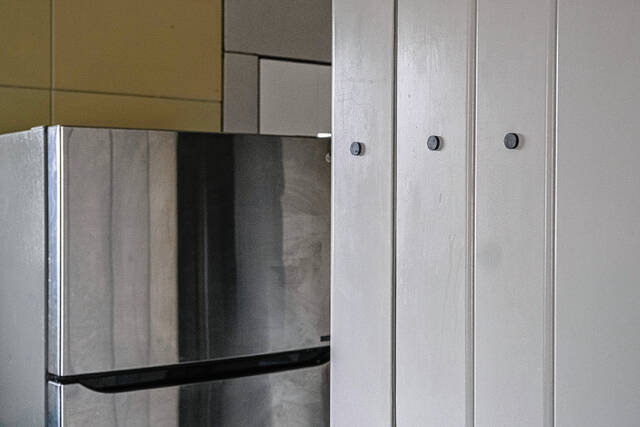
Mike Wolanin | The Republic Magnets cling to a wall in local architect Louis Joyner’s Lustron Home, an all metal kit home sold in the Sears catalog after World War II, in Columbus, Ind., Thursday, Feb. 24, 2022. The home has recently been added to the National Register of Historic Places. The home was sold and constructed in 1949.
Columbus architect Louis Joyner has been a key figure in recent, local, ongoing restoration projects with high-profile structures such as First Christian Church, North Christian Church and the Crump Theater.
But some of his most passionate and provocative work sits mostly unnoticed by the masses at 2121 Pennsylvania St. in Columbus, in an intimate, two-bedroom home nestled in a quiet neighborhood off the busy traffic of 25th Street.
The porcelain-enameled steel house represented a revolution in the home-building industry when it sprang up in town with six other such creations in 1949 — mostly as housing for World War II veterans in a tight home market.
The 1,085-square-foot Evans Lustron Corp. prefab home just was added to the National Register of Historic Places, besides a multiple property listing for Lustron homes locally.
The innovative house construction firm’s slogan in its two-year lifespan: “The House America Has Been Waiting For.”
“This was going to be really big,” Joyner said.
So big that 5,500 people, equaling about one-third of the city’s post-war population at the time, toured one one of the local Mead Village Lustron homes in 1949 — in one weekend.
The prefab unit, shipped in a 3,000-piece kit from a former airplane factory in Columbus, Ohio, and constructed by local builders Repp and Mundt in only a few days, still features the original roof and original, large, refurbished windows (plus smaller, porthole-style ones). And much of the blue and yellow enamel of the exterior still holds a proud sheen nearly three-quarters of a century later.
Joyner, who bought the house four years ago, spent the first days of the COVID-19 lockdown in 2020 making needed improvements. He eventually spent more than $25,000 and five months with his two sons rehabbing the home. It had been a rental for much of its life and was in “surprisingly good condition — a testament to the quality of its construction,” according to Joyner.
The home features steel throughout, from framing elements such as studs and trusses, to the interior panels and cabinetry.
The family crew used ammonia and mops to remove cigarette smoke stains from the walls and ceilings, replacing the kitchen, the flooring and undoing what Joyner called “unfortunate alterations.”
One son, Edward Joyner, lived there for a year.
“I did this (restoration and listing) not for me but for the house itself,” the architect said, emphasizing that the structure deserved better than to suffer the demolition, unfortunate alterations and disrepair that many of the nation’s 2,498 Lustron models and 206 Indiana models have seen.
Originally, promoters boasted that these structures were three times stronger than traditional, stick-built homes.
The trio aimed to remain as true to the original design as possible. They rescued a metal shelving unit from a shed on the property, giving it bright new maroon paint, and offering it a high-visibility spot on a kitchen wall, where it smartly matches a rubberized baseboard.
Perhaps the most striking, ahead-of-its-time feature of the home is ample closet space and shelving at a time when most home residents were not quite as consumer or clothes-oriented as today.
Some of the original closet doors have had to be replaced over the years. But the home retains much of its pre-IKEA-style charm, if you will.
Mark Dollase, vice president of preservation services for Indiana Landmarks, which champions historical preservation, saluted Joyner’s work.
“The Lustrons certainly were seen as more unique and quirky,” Dollase said. “And they were seen as easier to take care of and maintain because of the metallic materials.
“I really want to give Louis a lot of credit. He not only acquired this property for the right reasons in order to restore it, but he also is providing someone a high-quality, solid and affordable housing unit for someone in Columbus.”
Joyner is using a management company to coordinate details with renters, who just moved in on Friday. All he knows is that they are two young people.
They must adhere to such details as no nails in the wall for hanging decor. Magnets must be used instead.
“It amazes me that this house is as intact as it is, just because most houses have a hard life,” Joyner said. “People who have bought these through the years often have tried to normalize them by doing things such as putting vinyl siding on them. There was one Lustron here in town where someone had put wood paneling all over the interior and covering the very thing that was cool.
“That’s just how people sometimes are.”
Joyner loves the fact that the home is within close walking distance to a bank, a grocery, a variety of restaurants, and a host of other amenities and attractions.
Yet, he also loves the fact that it makes a home for trendy history in a town known for championing architecture.
“This was once such a new thing,” he said, “that it was seen as a threat to the wood products industry.”




